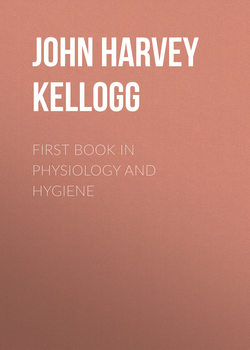Читать книгу First Book in Physiology and Hygiene - John Harvey Kellogg - Страница 5
CHAPTER III
ОглавлениеTHE INSIDE OF THE BODY
1. Thus far we have taken only a brief look at the outside of the body, just as if we had looked at the case of a watch, and of course we have found out very little about its many wonderful parts. Very likely you want to ask a great many questions, such as, How does the inside of the body look? What is in the skull? What is in the chest? What is in the abdomen? Why do we eat and drink? Why do we become hungry and thirsty? What makes us tired and sleepy? How do we keep warm? Why do we breathe? How do we grow? How do we move about? How do we talk, laugh, and sing? How do we see, hear, feel, taste, and smell? How do we remember, think, and reason? All these, and a great many more interesting questions, you will find answered in the following lessons, if you study each one well.
2. When we study the inside of the body, we begin to understand how wonderfully we are made. We cannot all see the inside of the body, and it is not necessary that we should do so. Many learned men have spent their whole lives in seeking to find out all about our bodies and the bodies of various animals.
3. The Bones.—If you take hold of your arm, it seems soft on the outside; and if you press upon it, you will feel something hard inside. The soft part is called flesh. The hard part is called bone. If you wish, you can easily get one of the bones of an animal at the butcher's shop, or you may find one in the fields.
4. The Skeleton.—All the bones of an animal, when placed properly together, have nearly the shape of the body, and are called the skeleton (skel´-e-ton). The skeleton forms the framework of the body, just as the heavy timbers of a house form its framework. It supports all the parts.
5. The Skull.—The bony part of the head is called the skull. In the skull is a hollow place or chamber. You know that a rich man often has a strong room or box in his fine house, in which to keep his gold and other valuable things. The chamber in the skull is the strong-room of the body. It has strong, tough walls of bone, and contains the brain. The brain is the most important, and also the most tender and delicate organ in the whole body. This is why it is so carefully guarded from injury.
6. The Backbone.—The framework of the back is called the backbone. This is not a single bone, but a row of bones arranged one above another. Each bone has a hole through it, about as large as one of your fingers. A large branch from the brain, called the spinal cord, runs down through the middle of the backbone, so that the separate bones look as if they were strung on the spinal cord, like beads on a string.
7. The Trunk.—The trunk of the body, like the skull, is hollow. Its walls are formed partly by the backbone and the ribs and partly by flesh. A fleshy wall divides the hollow of the trunk into two parts, an upper chamber called the chest, and a lower called the abdomen.
8. The Lungs and Heart.—The chest contains a pair of organs called the lungs, with which we breathe. It also contains something which we can feel beating at the left side. This is the heart. The heart lies between the two lungs, and a little to the left side.
9. The Stomach and Liver.—In the abdomen are some very wonderful organs that do different kinds of work for the body. Among them are the stomach, the bowels, and the liver. There are, also, other organs whose names we shall learn when we come to study them.
10. Care of the Body.—We have only begun to study the beautiful house in which we live, and yet have we not learned enough to show us how great and wise is the Creator who made us and all the wonderful machinery within our bodies? If some one should give you a beautiful present, would you treat it carelessly and spoil it, or would you take good care of it and keep it nice as long as possible? Ought we not to take such care of our bodies as to keep them in that perfect and beautiful condition in which our kind and good Creator gave them to us?
SUMMARY
1. The body has a framework, called the skeleton.
2. The skeleton is made up of many different parts, each of which is called a bone.
3. The bones are covered by the flesh.
4. The bones of the head form the skull, which is hollow and contains the brain.
5. A row of bones arranged in the back, one above another, forms the backbone. The backbone has a canal running through it lengthwise, in which lies the spinal cord.
6. The trunk is hollow, and has two chambers, one called the cavity of the chest, and the other the cavity of the abdomen.
7. The chest contains the two lungs and the heart.
8. The abdomen contains the stomach, liver, and many other very important organs.
9. Is it not our duty to take good care of our bodies as we would of some nice present from a friend?
